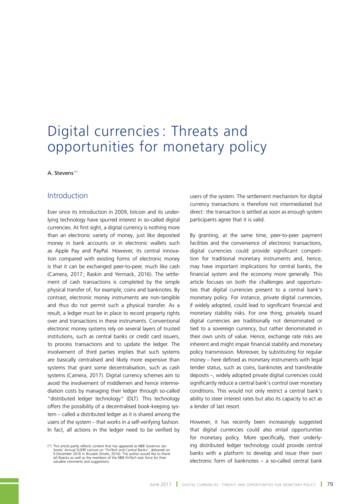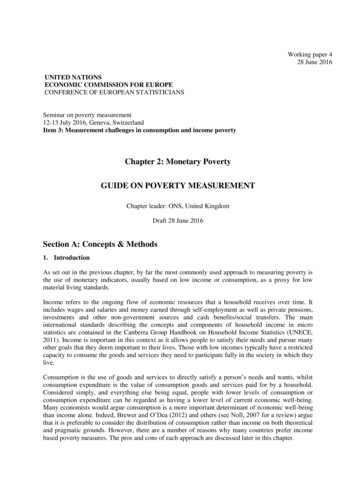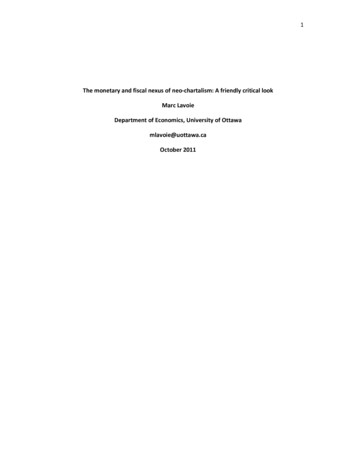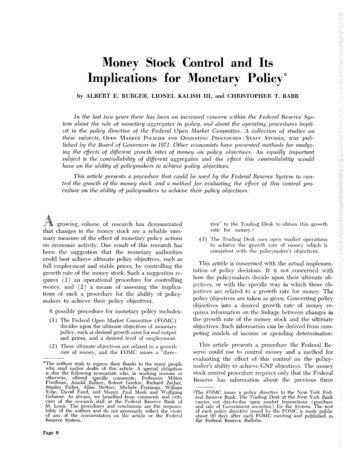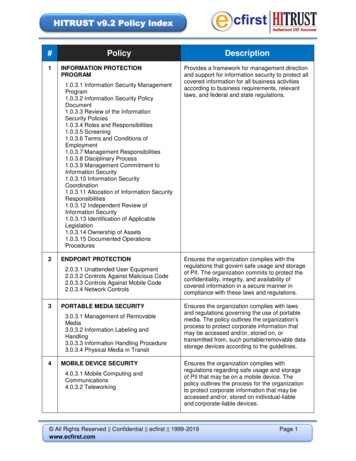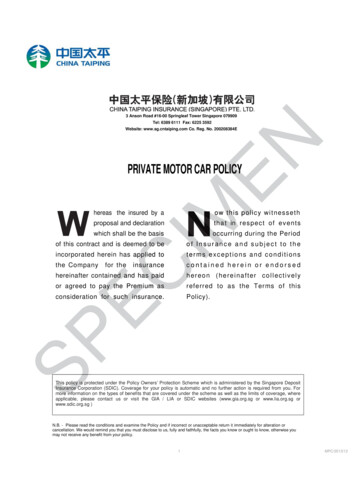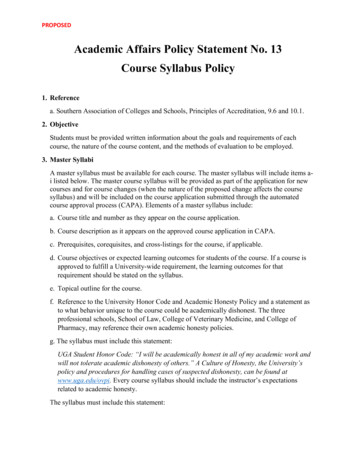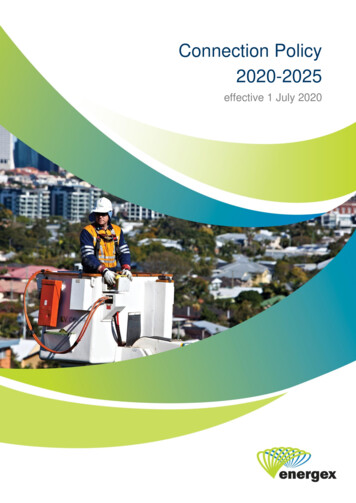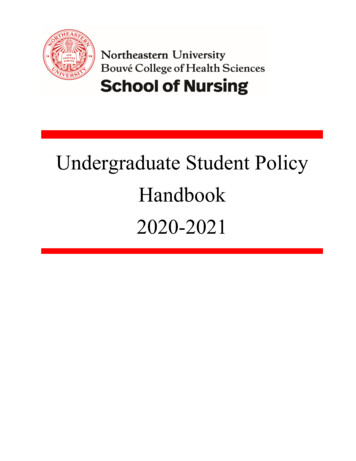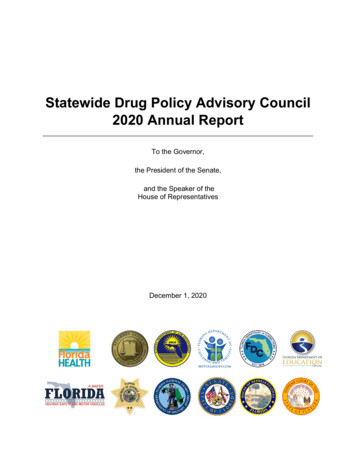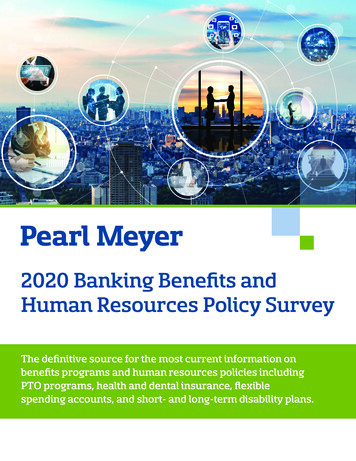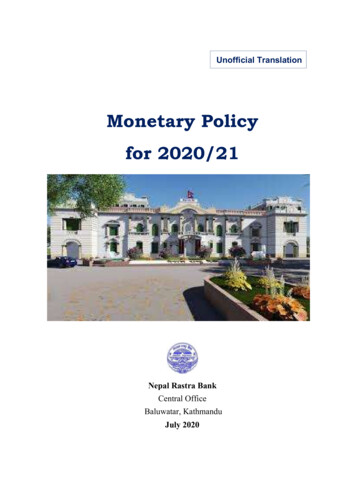
Transcription
Unofficial TranslationMonetary Policyfor 2020/21Nepal Rastra BankCentral OfficeBaluwatar, KathmanduJuly 2020
Monetary Policyfor 2020/21Delivered byGovernor Mr. Maha Prasad AdhikariOn 17 July 2020Nepal Rastra BankCentral officeBaluwatar, Kathmandu
Nepal Rastra BankCentral officeBaluwatar, KathmanduNepalPhone No: 4410158Website: www.nrb.org.np
TABLE OF CONTENTSBackground . 1Global Economic Outlook . 2Macro Economic Situation . 3Financial Sector Status. 4Review of Monetary Policy 2019/20 . 6Monetary Management . 6Review of Financial Sector Program . 7Major Policy Provisions in the Context of COVID-19 . 8Economic Outlook for 2020/21 . 9Monetary Policy Framework for 2020/21 . 10Monetary Policy Stance . 10Economic and Monetary Target . 10Operating Target and Instrument . 11Financial Sector Provisions for 2020/21 . 11Credit Provision . 11Special Programs for Economic Revival . 14Business Operation Credit for COVID-19 Affected Business . 15Moratorium, Loan Restructuring and Rescheduling . 15Financial Sector Consolidation. 16Regulation and Supervision . 17Microfinance. 19Payment System . 20Foreign Exchange Management . 21Corporate Governance, Financial Literacy and Consumer Protection . 22Annex 1Projection of Monetary SurveyList of Statistical Tables
:::::::::Agricultural Development Bank LimitedAnti-money LaunderingAutomated Teller MachineBanks and Financial InstitutionBalance of PaymentsCentral Bureau of StatisticsCountercyclical BufferCredit-to-Core Capital and DepositCombating the Financing of TerrorismCredit Information BureauCitizen Investment TrustConsumer Price IndexCash Reserve RatioCorporate Social ResponsibilityDocuments against AcceptanceDocuments against PaymentEmployee Provident FundForeign Direct InvestmentFinancial Sector Development StrategyGross Domestic ProductGovernment of NepalInternational Monetary FundInterest Rate CorridorKnow Your CustomerLetter of CreditLetter of IntentLender of the Last ResortLoan to ValueBroad MoneyMicrofinance Financial InstitutionMicro, Small and Medium EnterprisesNepal Stock ExchangeNepal Financial Reporting StandardsNon-Performing LoanNepal Rastra BankNon Resident Nepali
t FundPayment System Development IndicatorPayment System OperatorPayment Service ProviderQuick ResponseReal Time Gross SettlementStanding Liquidity FacilityStatutory Liquidity RatioSpecial Purpose Vehicleyear on year
Monetary Policy for 2020/21Background1.The monetary policy for 2020/21 has been formulated at a time when the wholeworld is undergoing humanitarian as well as economic crises stemmed from theCOVID-19. More than five hundred ninety three thousand people have lost their livesand more than fourteen million people have been infected due to an unanticipatedpandemic occurred after a century. The global economy has experienced the biggestcontraction after the Great Depression of 1930s. The health as well as economiccrises emanated from the COVID-19 may give rise to poverty, unemployment andincome inequality.2.The COVID-19 has created an unprecedented challenge in the goal of attaininghigher sustainable growth and maintaining social justice in order to realize thenational aspiration of "Prosperous Nepal, Happy Nepali". Unlike the robust economicgrowth attained in the past three years, lower growth is estimated for 2019/20.Though the growth remained subdued and credit expansion slowed, moderateinflation, decline in current account deficit, surplus balance of payments and higherdeposit growth support the macroeconomic fundamentals.3.Access to financial services has increased remarkably in the last few years. The useof digital means of payments is increasing along with the financial expansion.Further, the process of developing payments system infrastructure is movingforward. The increased use of mobile banking eased the settlement of bankingtransactions even during the period of lockdown.4.Labor market and remittance flows have been affected worldwide owing to theCOVID-19. The domestic labor market has witnessed an upsurge in labor supply withan increase in returnee migrants. Mobilizing deposit in the banking system,maintaining external sector balance and reducing poverty will be affected ifremittance slows down owing to the economic contraction in the labor destinationeconomies.5.The monetary policy, in the presence of the challenges posed by the COVID-19,reinforces economic recovery while maintaining macroeconomic stability. Given this,the policy is directed towards management of credit and enhancing further credit toCOVID-hit areas. Further, the credit should be channelized towards increasing
2Nepal Rastra Bankproduction, generating employment and promoting entrepreneurship with a goal offostering economic activities and reviving the economy.6.Monetary policy for 2020/21 has been formulated following the mandate of the NepalRastra Bank Act, 2002. The policy is formulated taking into account the domestic aswell as international economic outlook along with the Fifteenth Plan of theGovernment of Nepal (GoN), Government Budget for 2020/21, Financial SectorDevelopment Strategy (FSDS) and the Third Strategic Plan of Nepal Rastra Bank(NRB). Suggestions from various stakeholders have been duly considered whileformulating the policy.Global Economic Outlook7.World economy contracted on account of the production and supply chain disruptionsthat resulted from the measures adopted worldwide to contain the spread of COVID19. According to the World Economic Outlook updated by the InternationalMonetary Fund (IMF) in June 2020, the world economy is projected to contract by4.9 percent in 2020.8.The Advanced economies are projected to contract by 8.0 percent in 2020 comparedto an expansion of 1.7 percent in 2019. The emerging and developing economies areprojected to contract by 3 percent in 2020 compared to an expansion of 3.7 percent in2019.9.The IMF has projected the Asian economies to contract by 1.6 percent in 2020. Whilethe Indian economy is projected to contract by 4.5 percent, the Chinese economy isprojected to expand by 1 percent. The IMF projects the growth rate of Nepal toremain 1 percent in 2020.10. Inflation has moderated with contraction in aggregate demand and falling oil pricedue to the effect of COVID-19. The IMF has projected inflation in the developedeconomies to remain 0.3 percent in 2020 compared to 1.4 percent in 2019. The Fundhas projected inflation to remain 4.4 percent in the emerging and developingeconomies in 2020 compared to 5.1 percent in 2019.11. A large number of countries around the world have adopted expansionary monetaryand fiscal policy to cope with the challenges stemmed from the pandemic. Despitethe uncertainties caused by COVID-19, many countries have been easing lockdownin order to revive economic activities.
Monetary Policy for 2020/21 3Macroeconomic SituationGrowth and Inflation12. As per the preliminary estimate of the Central Bureau of Statistics (CBS), GrossDomestic Product (GDP) is estimated to grow by 2.28 percent in 2019/20 comparedto a growth of 7 percent in the previous year. Agriculture, industry and service sectorare estimated to grow by 2.6 percent, 3.2 percent and 2 percent respectively in2019/20.13. Ratios of Gross Domestic Savings and Gross National Savings to GDP are estimatedat 18.1 percent and 46 percent respectively in 2019/20. In the previous year, suchratios were 19 percent and 48.9 percent respectively.14. Ratios of Gross Fixed Capital Formation and Gross Capital Formation to GDP areestimated at 28.1 percent and 50.2 percent respectively in 2019/20. In the previousyear, such ratios were 33.7 percent and 56.6 percent respectively.15. CPI inflation, on y-o-y basis, remained 4.54 percent in mid-June 2020. Likewise,average inflation in the eleven months of 2019/20 recorded 6.28 percent compared to4.51 percent a year ago.Government Expenditure, Revenue and Internal Debt Mobilization16. According to the Office of the Financial Comptroller General, total expenditure of thefederal government stood at Rs. 1094.34 billion in 2019/20. This includes recurrentexpenditure of Rs.786.53 billion, capital expenditure Rs.191.77 billion and financingexpenditure Rs. 116.04 billion. In the review year, revenue mobilization stood Rs.841.36 billion.17. The GoN raised domestic debt of Rs. 194.64 billion and made repayment of Rs.34.39 billion in 2019/20. This resulted in the net domestic debt mobilization of Rs.160.25 billion (4.3 percent of GDP).Foreign Trade, Remittance and Balance of Payment18. Export increased by 0.2 percent to Rs. 88 billion and import declined by 15.3 percentto Rs 1100.81 billion in the eleven months of 2019/20. Trade deficit improved by16.4 percent in the review period whereas remittance inflow decreased by 3 percentto Rs. 774.87 billion.
4Nepal Rastra Bank19. Current account deficit stood Rs. 71.64 billion and Balance of Payments (BOP)remained at a surplus of Rs.179.37 billion in the eleven months of 2019/20. Currentaccount deficit was Rs. 249.08 billion and BoP deficit was Rs.90.83 billion in thecorresponding period of the last year.20. Gross foreign exchange reserve of the banking system stood Rs. 1306.46 billion(USD 10.79 billion) in mid-June 2020. Based on the imports of the eleven months of2019/20, foreign exchange holding of the banking sector is sufficient to coverprospective merchandise imports for 13.3 months and merchandise and serviceimports for 11.7 months.21. Nepalese currency vis-à-vis the USD depreciated by 9.15 percent in mid-July 2020compared to mid-July 2019. The buying rate for one USD stood at Rs.120.37 in midJuly 2020.Financial Sector SituationBanking Sector22. Deposit mobilization of the BFIs increased by 13.3 percent to Rs. 3666.62 billion inthe eleven months of 2019/20. During the same period of the previous year, depositmobilization had increased by 13.3 percent to Rs. 3105.74 billion.23. Outstanding credit of the BFIs increased by 10.7 percent during the eleven months of2019/20 to Rs. 3172.98 billion in mid-June 2020. During the same period of theprevious year, outstanding credit had increased by 18.2 percent to Rs. 2836.07billion.24. Of the outstanding credit of the BFIs in mid-April 2020, the share of credit up to Rs.1.5 million recorded 15 percent and Rs. 1.5 million to Rs 5 million recorded 24.9percent. Similarly, credit from Rs. 5 million to Rs. 10 million, Rs. 10 million to Rs.50 million and more than Rs. 50 million stood 10.2 percent, 22.3 percent and 27.6percent respectively.25. Paid-up capital of the BFIs stood. 349.59 billion in mid-June 2020. This is an 8.2percent increase from mid-July 2019. Similarly, capital fund increased by 9.8 percentto Rs. 518.05 billion in the review period.26. Capital adequacy ratio of commercial banks, development banks and financecompanies stood at 13.4 percent, 13.4 percent and 18.7 percent respectively in mid-
Monetary Policy for 2020/21 5June 2020. Such ratios were 14 percent, 16 percent and 20.4 percent respectively inmid-July 2019.27. Non Performing Loan (NPL) of the BFIs stood 1.81 percent in mid-April 2020compared to 1.52 percent in mid-July 2019. NPL of commercial banks, developmentbanks and finance companies stood at 1.72 percent, 1.48 percent and 6.76 percentrespectively in mid-April 2020.28. Altogether 196 BFIs (including 25 commercial banks) have been involved in themerger and acquisition process thereby forming 46 institutions in a decade. This ismainly because of the facilitation given by this Bank to such initiatives. In thisprocess, license of 150 institutions including 5 commercial banks have been revoked.In 2019/20, altogether 35 BFIs including 4 commercial banks were merged andacquired and license of 20 institutions was revoked.29. Financial access has increased along with the expa
6. Monetary policy for 2020/21 has been formulated following the mandate of the Nepal Rastra Bank Act, 2002. The policy is formulated taking into account the domestic as well as international economic outlook along with the Fifteenth Plan of the Government of Nepal (GoN), Government Budget for
